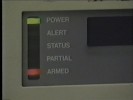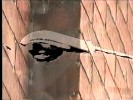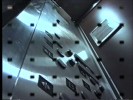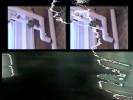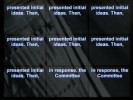future.surface.(text)ure, 2003
“future.surface.(text)ure” Art in General – The Armory Show, New York
Commissioned by Art in General, around the time of its 20 year anniversary, and in conjunction with the exhibit “Reconfiguring Space: Blueprints for Art in General,” which was a two-phase competition to redesign space at Art in General. The one hour long video artwork on DVD served as a multiple released at a benefit in association with this exhibition, and was then presented at Art in General’s booth at the Armory Show.
Video Stills:
Project Description:
future – The time or a period of time following the moment. Events that will or are likely to happen in the time to come. A prospect of success or happiness. Likely to happen or exist.
surface – To apply a surface to something. To work a mine near the surface. For information or facts to become known. To rise to the surface. To come out of hiding.
texture – The feel, appearance, or consistency of the outer part of a substance. A rough or raised finish. The tactile quality of the surface of a work of art.
text – A work, regarded in terms of its content rather than its physical form. A piece of written material regarded as conveying the authentic or primary form. Computing data in written form, especially when stored, processed, or displayed. A script. A work chosen or assigned as a subject of study. A textbook. A passage from the Bible or other religious work, especilly when used as the subject of a sermon, or lesson. From Latin textus ’tissue’, from text – ‘woven’.
future.surface.(text)ure explores Art in General both as a building and as an institution, using the ideas of future, surface, texture, and text. Though non-narrative, it borrows elements of the theories of Mircea Eliade, historian of religion and founder of the Chicago School, to weave an hour long video collage about architecture, time, and meaning. Other influences include Futures Studies, Environmental Psychology and Interstitial Urbanism, recent work on architecture and terrorism, as well as theories of digital and relational architecture.
The work applies multiple simultaneous surfaces through video mixing, layering and collage. The images are at times hypnotic and disorienting. They seem liquified, dematerialized, and are used to make the familiar seem strange. Certain qualities in the video even suggest the spy, thriller, or horror movie genres. A man in a trench coat walks briskly past, clutching a valise. The camera in first person perspective, crouches, peering slowly around corners, through doorways, and up staircases. The whole thing has a real, gritty, Downtown New York, Lower East Side feel. Yet it also evokes the future and the digitization of experience.
According to Eliade there are two kinds of time, “sacred” and “profane”. Profane is the mundane everyday existence of linear time with a past, present, and future. Sometimes we can have encounters which take us out of the normal and open us up to another level, or plane of existence – an expanded timeless awareness. Shamans are said to be able to travel to this timeless, sacred, or origin time, but anyone, regardless of religion or lack there of, can have this kind of revelatory experience. When we do, we can be exposed to the fundamental organizing principles of meaning in our lives. The idea is that a kind of axis mundi opens up a transition point between planes of existence. Suddenly multiple times exist simultaneously and a kind of permeable surface opens where boundaries dissolve and we cross over to this other state. A different way in, than using the front door.
For Eliade these sacred crossover encounters or “Hierophanies” give structure and orientation to the world. Profane time/space can only be divided up geometrically, it has no qualitative differentiation and thus no orientation. Treating something as sacred is in contrast to treating something with disrespect, irreverence, or even simply undue familiarity, and it is a way to identify value. As the word “sacred”, in all languages, universally denotes to cut, to set apart, to mark off, then future.surface.(text)ure seeks to make manifest what Art In General is, and what sets it apart.
Futures studies attempts to to gain a holistic and systemic view by examining not only possible but also probable, preferable, and “wild card” futures. It tries to make us aware of our unexamined assumptions through novel approaches. These include “backcasting” which, (unlike forecasting that tries to predict the future based on current trend analysis), approaches the challenge of discussing the future from the opposite direction. This issue of future, time, and alternative approach is very much at the heart of future.surface.(text)ure.
Environmental psychology is an interdisciplinary field and defines the term environment very broadly to include social settings, built environments, learning environments and informational environments which can all be studied together. In the book from the Interstitial Urbanist school of thought entitled “The Ordinary City” the urban world is described as a site of co-presence of multiple spaces, multiple times and multiple webs of relations, tying local sites, subjects and fragments into globalizing networks of economic, social and cultural change. In both areas of study this notion of simultaneous overlapping networks of experience occurs, and the idea is echoed in the structure of future.surface.(text)ure.
In the post 9/11 world, the danger of architecture being a target for terror resulted in new kinds of urban anxiety. This in turn led to an increase in the sometimes totalitarian technological systems for monitoring and control in the name of safety, and a new kind of architectural paranoia. future.surface.(text)ure focuses on this issue by highlighting related infrastructure such as security monitoring systems with power, alert, and armed status lights, telecommunications wiring, fire extinguishers, fire alarm pull boxes, and even features like the uncommon new frequency of helicopter surveillance in the neighborhood.
future.surface.(text)ure also explores notions of data space, and how Art in General as an entity inhabiting architecture positions itself and networks out into the world, as well as how the institution is working with artists and architects on visions for the future. This includes an awareness of how marketing works as a kind of rewriting and fictionalizing to tell a mythic origin story of an institution. In the video, physical surface texture is divided into grid structures and text pixelates in and out of legibility, suggesting the digitization of architecture and communication.
Infrastructure can be defined as the basic physical and organizational structures needed for the operation of a society or enterprise and future.surface.(text)ure focuses, in great detail, on a long list of infrastructural elements including light switches, track lights, water and sprinkler pipes, heating pipes, electrical conduit, stand pipes, fire escapes, stair rails and uprights, signage, rigging hardware, expanded metal mesh window guards and more. It also lavishes extended moments on extreme close ups of basic construction materials including concrete, diamond plate steel, expanded metal mesh, and brick.
Architectural design and urban planning are big subjects but ones which tend to reduce the rich physical materiality of lived experience into a set of restricted concepts associated with design. Buildings become toy objects and fundamental experience is vacuumed away in order to create an efficient and streamlined environment in which to plan. This reduction has many positive effects, freeing the mind, and allowing one to conceive totally new notions about materials and spacial relationships. But it also has a negative side in that we no longer see the “there” which is recorded in memory, the “not new” of the rusting fire escape, and the scuffs on the floor that document the passing incidents of human presence.
In our mundane existence we often see architecture in relation to our immediate use of it, going to a meeting in the office or installing an artwork in the gallery. It is easy forget that the timescale of architecture greatly outlasts us. Urban structures survive on a longer time scale than the “people-years” of the short lived human inhabitants who briefly pass through them.
Through extreme close up videography, cutting, layering, and video filtration, future.surface.(text)ure looks at the social, temporal, and spatial ordering of Art In General. By de-structuring and turning upside down, and inside out, it seeks to reach a new and altered perspective. Lonely, elegiac, contemplative. The video becomes a sacred journey into the heart of this Lower East Side mainstay, to find orientation and meaning.
While exploring the back way of Cortlandt Alley we hear dogs barking, reggae music with it’s relation to spirituality and with its strongly accented subsidiary beat, and we see the puffs of steam rising from vent pipes, and the profusion of steel bars which make up the complex network of fire escapes. As the camera dangles down sixty feet to the street below, swinging to and fro, we can feel the pulse of the city hiding below the surface.
future.surface.(text)ure seeks to provoke an epiphany regarding our place within the larger scale of the physical existence of the city. The minute unseen details of urban infrastructure flow past us, like ghosts in a visual poem about the built environment – an architectural elegy for a lost New York.
